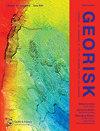A novel long-short term memory network approach for stress model updating for excavations in high stress environments
IF 4.8
3区 工程技术
Q1 ENGINEERING, GEOLOGICAL
Georisk-Assessment and Management of Risk for Engineered Systems and Geohazards
Pub Date : 2023-01-02
DOI:10.1080/17499518.2023.2182889
引用次数: 2
Abstract
ABSTRACT Digitalisation has increased access to large amounts of data for rock engineers. Machine learning presents an opportunity to aid data interpretation. The operators of Garson Mine use a microseismic database to calibrate a mine-scale finite difference model, used to assess seismic risk to inform mine operations. A Long-Short Term Memory (LSTM) network is proposed for stress model updating. The model is trained using microseismic data, geology, and geomechanical parameters from the FLAC3D model. Two LSTM networks are developed for Garson Mine: (1) predicting far field principal stresses in the FLAC3D model, and (2) predicting the far field six-component stress tensors in the model. Various LSTM network hyperparameters were analyzed to determine the architecture for the targets: input encoding and pre-processing, training solver, network layer architecture, and cost function. Architectures were chosen based on the corrected Akaike Information Criterion (AICc), coefficient of determination (R2), and percent capture (%C). When predicting principal stresses, AICc = −59.62, R2 = 0.996, and %C = 97%, and when predicting the six-component stress tensor AICc = −45.50, R2 = 0.997, and %C = 80%. This research represents progress towards continuous, automated updating of numerical models such that rapid, more accurate forecasts of changes in stress conditions will allow earlier reaction to challenging stress environments, increasing safety of excavations.一种新的长短期记忆网络方法用于高应力环境下挖掘的应力模型更新
摘要数字化增加了岩石工程师获取大量数据的机会。机器学习提供了一个帮助数据解释的机会。Garson矿山的运营商使用微震数据库来校准矿山规模的有限差分模型,该模型用于评估地震风险,为矿山运营提供信息。提出了一种用于压力模型更新的长短期记忆(LSTM)网络。该模型使用FLAC3D模型的微震数据、地质和地质力学参数进行训练。为Garson矿山开发了两个LSTM网络:(1)在FLAC3D模型中预测远场主应力,(2)在模型中预测近场六分量应力张量。分析了各种LSTM网络超参数,以确定目标的架构:输入编码和预处理、训练求解器、网络层架构和成本函数。架构的选择基于修正后的Akaike信息标准(AICc)、决定系数(R2)和捕获百分比(%C)。预测主应力时,AICc = −59.62,R2 = 0.996和%C = 97%,并且当预测六分量应力张量AICc时 = −45.50,R2 = 0.997和%C = 80%。这项研究代表了数值模型的连续、自动更新的进展,以便对应力条件的变化进行快速、更准确的预测,从而能够更早地对具有挑战性的应力环境做出反应,提高挖掘的安全性。
本文章由计算机程序翻译,如有差异,请以英文原文为准。
求助全文
约1分钟内获得全文
求助全文
来源期刊
CiteScore
8.70
自引率
10.40%
发文量
31
期刊介绍:
Georisk covers many diversified but interlinked areas of active research and practice, such as geohazards (earthquakes, landslides, avalanches, rockfalls, tsunamis, etc.), safety of engineered systems (dams, buildings, offshore structures, lifelines, etc.), environmental risk, seismic risk, reliability-based design and code calibration, geostatistics, decision analyses, structural reliability, maintenance and life cycle performance, risk and vulnerability, hazard mapping, loss assessment (economic, social, environmental, etc.), GIS databases, remote sensing, and many other related disciplines. The underlying theme is that uncertainties associated with geomaterials (soils, rocks), geologic processes, and possible subsequent treatments, are usually large and complex and these uncertainties play an indispensable role in the risk assessment and management of engineered and natural systems. Significant theoretical and practical challenges remain on quantifying these uncertainties and developing defensible risk management methodologies that are acceptable to decision makers and stakeholders. Many opportunities to leverage on the rapid advancement in Bayesian analysis, machine learning, artificial intelligence, and other data-driven methods also exist, which can greatly enhance our decision-making abilities. The basic goal of this international peer-reviewed journal is to provide a multi-disciplinary scientific forum for cross fertilization of ideas between interested parties working on various aspects of georisk to advance the state-of-the-art and the state-of-the-practice.

 求助内容:
求助内容: 应助结果提醒方式:
应助结果提醒方式:


